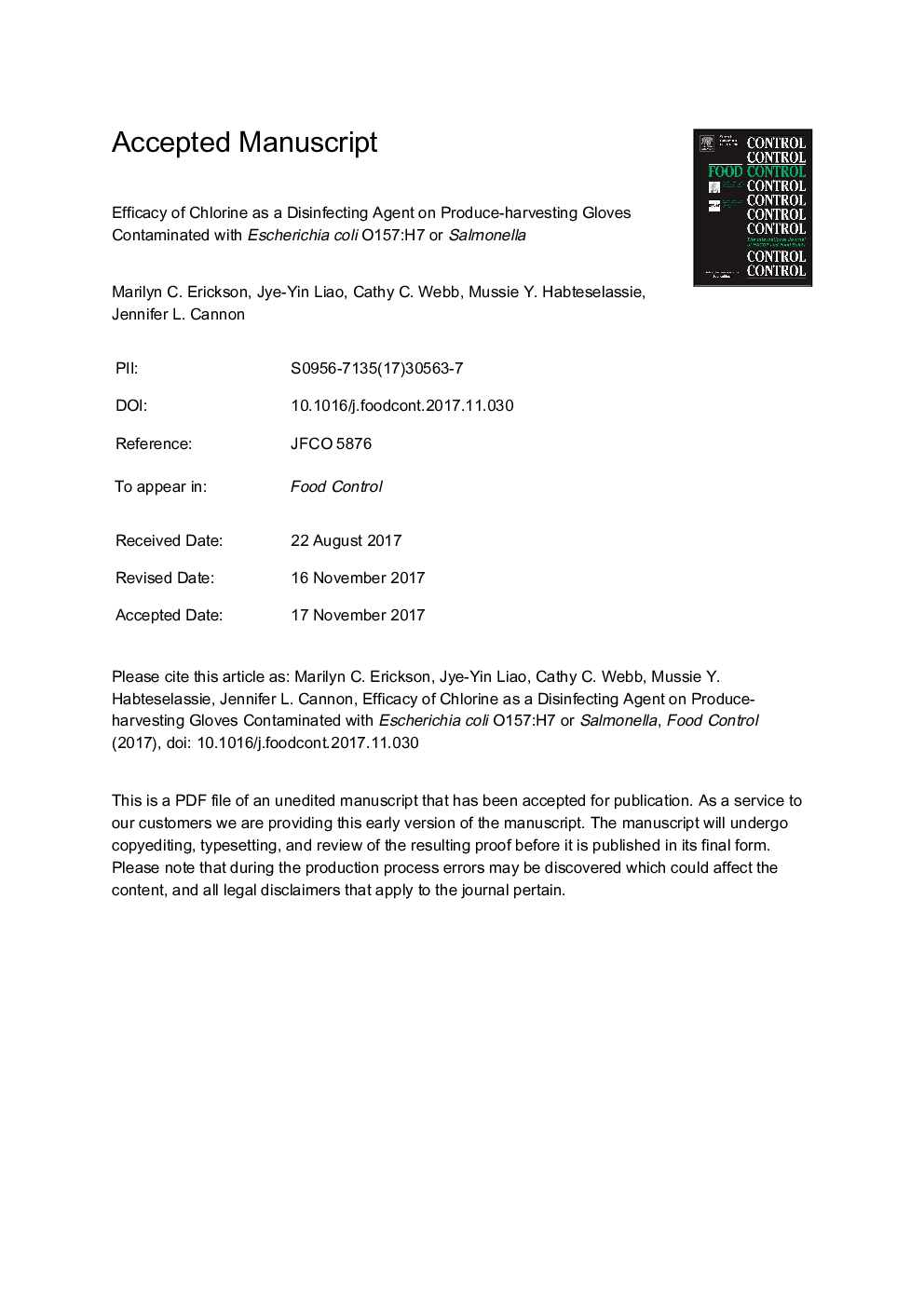| کد مقاله | کد نشریه | سال انتشار | مقاله انگلیسی | نسخه تمام متن |
|---|---|---|---|---|
| 8888161 | 1628378 | 2018 | 34 صفحه PDF | دانلود رایگان |
عنوان انگلیسی مقاله ISI
Efficacy of chlorine as a disinfecting agent on produce-harvesting gloves contaminated with Escherichia coli O157:H7 or Salmonella
دانلود مقاله + سفارش ترجمه
دانلود مقاله ISI انگلیسی
رایگان برای ایرانیان
کلمات کلیدی
موضوعات مرتبط
علوم زیستی و بیوفناوری
علوم کشاورزی و بیولوژیک
دانش تغذیه
پیش نمایش صفحه اول مقاله

چکیده انگلیسی
To minimize pathogen transfer from field worker's hands during hand harvest of ready-to-eat produce, gloves are often worn. However, fields are not sterile environments and transfer of pathogens to the gloves could occur throughout the day if the gloves come into contact with contaminated materials such as soil and produce. Given that changing gloves repeatedly is a costly solution, the merits to disinfecting gloves with chlorine solutions in the field were explored with efficacy (percent prevalence of gloves that were negative or positive for the pathogen) evaluated by subjecting the treated gloves to enrichment culture. Both the glove's level of pathogen contamination and chlorine exposure concentration affected the efficacy (P = 0.0000 and 0.0025, respectively). For example, complete elimination of Salmonella inoculated at ca. 3 log CFU/nitrile glove piece occurred at 50 ppm chlorine. However, when glove pieces had initial levels of ca. 6 log CFU E. coli O157:H7, exposure to 175 ppm did not completely eliminate the pathogen. Moreover, the likelihood of E. coli O157:H7 and Salmonella surviving were 32.0 and 4.4 times greater when the pathogen had been cultured on solid agar versus in liquid broth (95% CIs: 10.9 to 94.3 [P = 0.0000] and 2.1 to 8.9 [P = 0.0000], respectively). Another observation of this study was that dirty gloves exposed to both soil and lettuce sap were 11.6 times more likely than clean gloves to have the pathogen present after chlorine treatment (95% CI: 3.4 to 39.2, P = 0.0000). Monitoring these wash solutions for active chlorine revealed that no more than a 50% drop occurred suggesting that sufficient active chlorine remained for inactivating suspended pathogens and preventing cross-contamination. This data together with the observation that washing gloves in a second fresh batch of chlorine had little effect on the number of gloves absent of contamination would suggest that soil and sap is likely serving to protect the pathogen from exposure to the chlorine disinfectant. In an attempt to remove these materials, scrubbing during the chlorine immersion did not affect the efficacy of contaminated nitrile gloves (P = 0.1054) and actually led to a decreased efficacy of the chlorine treatment on contaminated Canners gloves (P = 0.0308). Although Salmonella and E. coli O157:H7 residing on nitrile and Canners gloves that survived exposure to 200 ppm chlorine could be transferred to produce handled by the treated gloves, frequent washing of gloves with chlorine could be an effective risk reduction strategy as they would reduce the numbers of gloves that may be contaminated with low levels of pathogens.
ناشر
Database: Elsevier - ScienceDirect (ساینس دایرکت)
Journal: Food Control - Volume 86, April 2018, Pages 257-265
Journal: Food Control - Volume 86, April 2018, Pages 257-265
نویسندگان
Marilyn C. Erickson, Jye-Yin Liao, Cathy C. Webb, Mussie Y. Habteselassie, Jennifer L. Cannon,